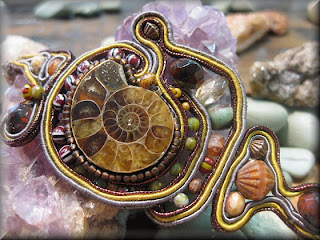I have always been fascinated by fossils, and once I
discovered ammonites, I feel like I’ve been possessed with fossil fever. Their
natural and unusual shapes, colors and sizes create endless opportunities for a
variety of one-of-a-kind fossils.
Ammonites got their name from the Egyptian God Ammon, the
God of life and procreation, who is often depicted with Rams’ horns behind each
ear. The fossil was considered Ammon’s stone, thus inheriting the name. The
snail-like spiral curl is the most recognizable attribute of ammonite fossils.
To me, that curl is the factor that draws my interest to those seemingly moving
fossils.
It is believed that ammonites were free-swimming mollusks
living around the same time that dinosaurs walked the earth, and disappearing
during the same extinction event. They grew in a range of sizes from a couple
of centimeters to over three feet in diameter. How fascinating is it to look at
those tiny ammonites and see the amount of detail preserved for all those
years.
 Ammonite fossils are usually cut in half and polished to a
high shine on the cut side. The inner sections resemble a nautilus and are
often filled with minerals and sometimes druze (crystallized) pockets. The
exterior surface sometimes has an iridescent sheen in red, green or amber
colors. The underside is usually rounded where it is removed from the stone in
which it had fossilized. I love ammonite pendants that have holes drilled
across the top because you have access to the under side to enjoy the beauty it
brings, and not just the polished smooth inner surface.
Ammonite fossils are usually cut in half and polished to a
high shine on the cut side. The inner sections resemble a nautilus and are
often filled with minerals and sometimes druze (crystallized) pockets. The
exterior surface sometimes has an iridescent sheen in red, green or amber
colors. The underside is usually rounded where it is removed from the stone in
which it had fossilized. I love ammonite pendants that have holes drilled
across the top because you have access to the under side to enjoy the beauty it
brings, and not just the polished smooth inner surface.
While it is said that ammonites are found in every country,
there is an abundant amount found in Madagascar ,
in Africa . Many of the fossils we have found
in our travels to the Tucson Gem and Mineral shows have been from Madagascar
Along with uses such as bead embroidery, wire wrapping, cuff
links, I have even seen the larger sizes used as paperweights, sculptures, and
objects for home or office decorating. This fascinating remnant of earth’s past
living creatures is sure to spark your interest too!
~Barbara





Hi girls!! I found you! It was lovely to spend time in your amazing shop and studio yesterday....I will send a photo displaying my beautiful new necklace when I am strutting my stuff at the Houston quilt show! I did a little story about you on my blog yesterday....as I said - "lucky New Jersey guys and girls having you!" May our paths cross again one day XX
ReplyDeleteAs a recent resident of Pennington, NJ one jewel I discovered is your store. It's a cultural walk through a museum. I was equally delighted to see your ammonites, which was the subject of a book I enjoyed thoroughly, Remarkable Creatures by Tracy Chevalier. I've already begun to bring my broken jewels to be fixed at your store. Your artwork may yet inspire me to learn to create my own!
ReplyDelete